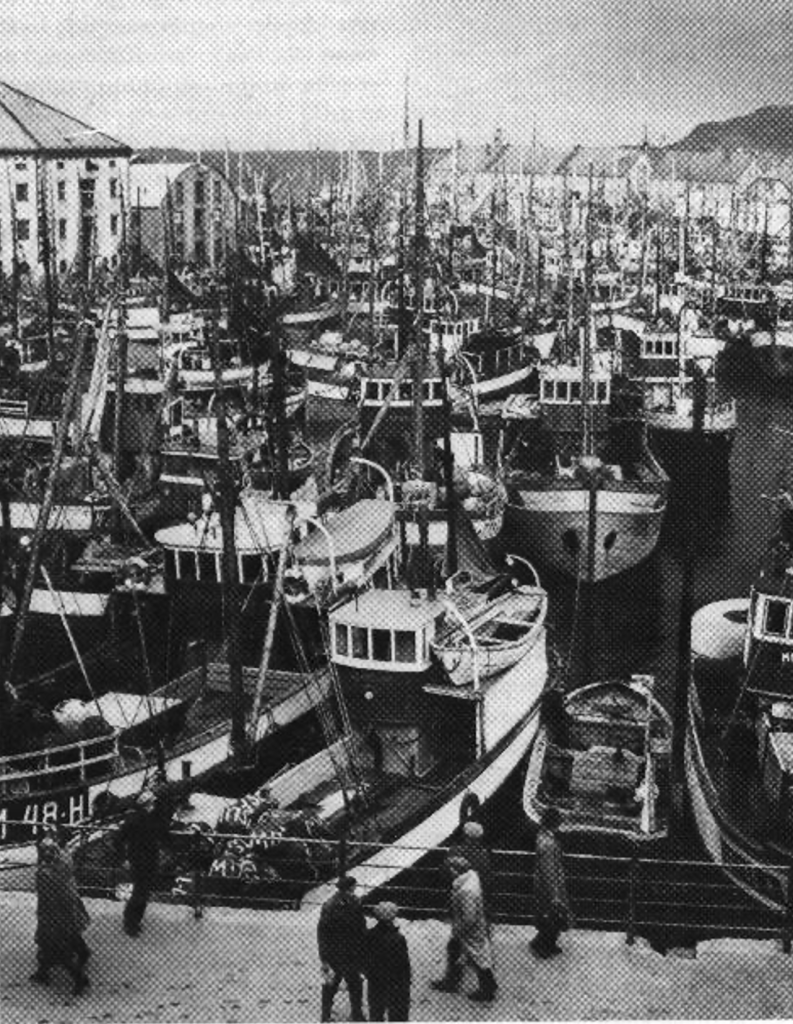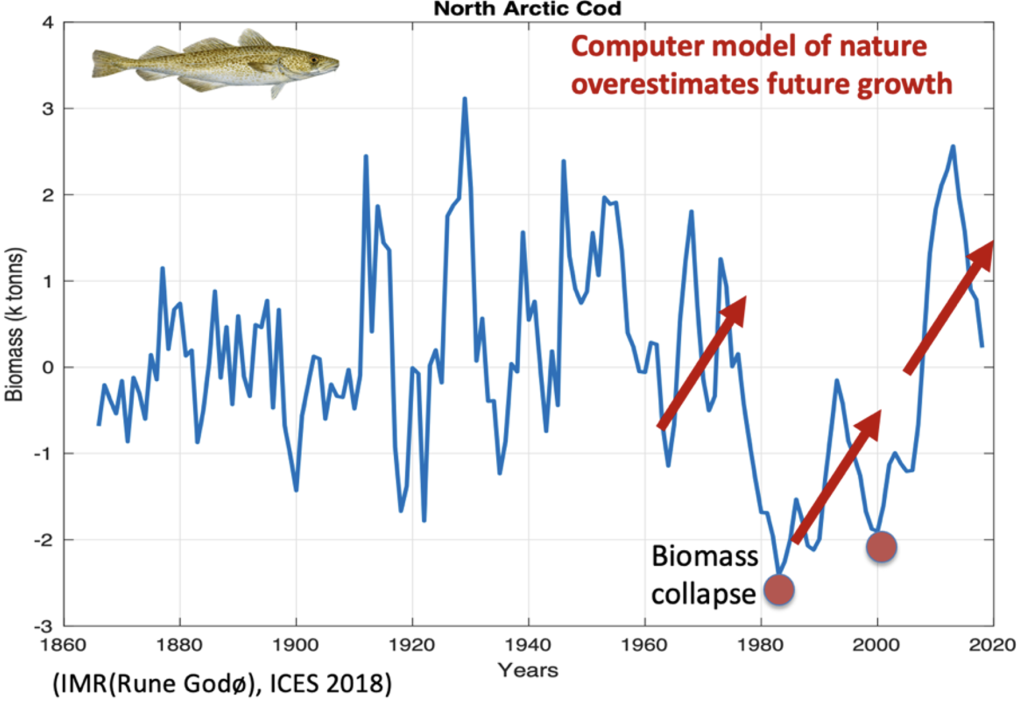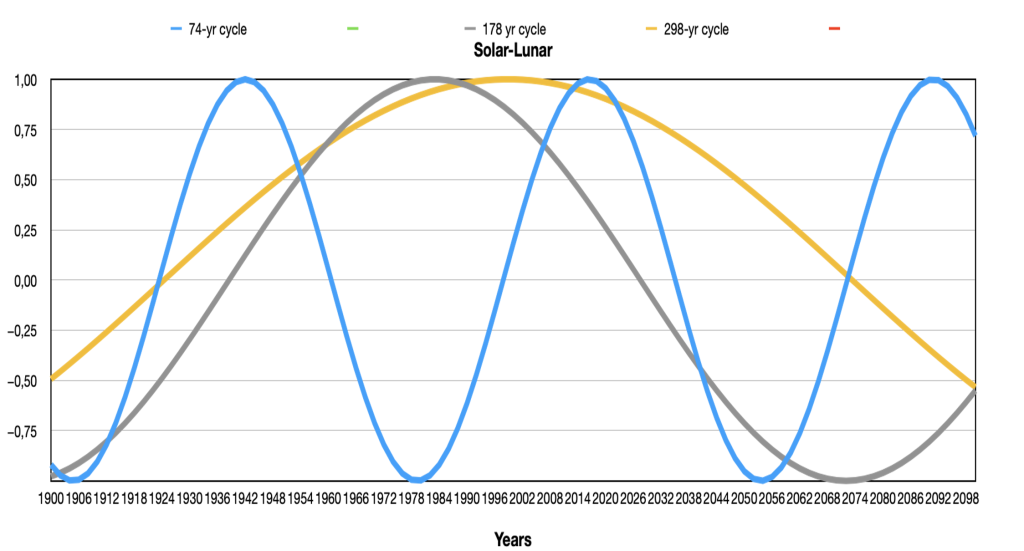What caused golden years and hunger years in the fisheries? Was it created by the fishing industry, scientists, or Our Lord. A new upcoming cold climate period will lead to reduced global growth, and less global food production. In this context, is a consensus-based climate research, a hunger game?
Fishery in golden years and hunger years

Figure 1. Ålesund in the 1960´s
We followed the big fishery, from the fishery channel on the radio. The herring catch were larger than one ship could handle, and fishing boats needed helpers to save the catch. The whole town took part in harvesting the herring silver from the sea. Those who were not involved in fishery, participated in repairs of equipment, building better fishing boats, better work clothes, and making better equipment. All that was needed, to catch more fish. School children took their time off, to unload herring from loaded fishing vessels. The herring time was a golden age, until the herring unexpectedly disappeared.

Figure 2. Biomass of North Atlantic cod, 1980 to 2018.
Hunger year periods
The cod population has always had great variations. Variations, which had created prosperity in good years, poverty, and hunger in bad years. A cod stock had built up, in good years in the 1940s. In the 1950s, it was time to change to steam-powered fishing boats and build a modern fishing fleet. Then came the 1960s, with expected continued growth, but in 1966 the collapse of the herring stock was a fact. Ring net, asdic and power block had revolutionized fishing, and less and less herring could escape from the fishermen’s tools. The 1970s brought good years, new optimism, and a new fishing fleet, but the optimism was hasty. The worst years ever record came in the early 1980s. In the 1990s came a new message about upcoming good years, which also turned out to be hasty.
Collapse in biomass stocks
It is not easy to count the number of fish in the sea. Established practice was to use static models to find the best biomass estimate. A fundamental model problem is to separate measured uncertainty from changes in biomass growth. The model then will not discover the biomass turning point. When reduced growth coincide with estimated growth, the biomass will reduce its sustainability and collapses.
The first cause
A statistical analysis of Norwegian Arctic cod from 1946 showed that the cod population had a periodic change of approx. 6 years. This would normally not be possible. This means that there is something predictable in nature that affects the ecosystem in the Barents Sea. It could be the temperature. If it is correct, it must mean that there is a periodic climate change in the Barents Sea.
The PINRO marine institute in Murmansk has measured the temperature in the Barents Sea at the Kola incision for more than 100 years. It turned out that the temperature has periodic cycles of approx. 18 and 74 years. The cod stock had optimized its growth over time by recruiting in periods of approx. 6 years. Two good spawning in the warm temperature period and a lesser spawning in the cold period.
The entire food chain in the Barents Sea was adapted to the temperature cycle of 18 and 74 years. The 18-year cycle has control of new recruitment. The 74-year cycle regulates the overall growth in the ecosystem. The sum of the temperature cycles regulates fishery in golden year and hunger years. The hunger years have a coincidence to cold climate periods. In cold climate periods, everything in nature grows more slowly, and ecosystems take care of its sustainability, by more mortality.
Climate periods in the Barents Sea, reveals a possible unknown periodic source. A first causes, in a chain of events, which causes golden years and and hunger years in the fishing industry. The suspicion fell on the Earth’s rotation and the tides.
Lunar climate machine
Studying changes in nature, from a simple series of measurements, is like studying a piece from a puzzle. A new analysis method made it possible to compare cycle periods from more than 100 climate data series. It was like putting together the whole puzzle, into a unified picture. The whole picture proved that the moon was the first cause, in a chain of events from Earth axis movement to fishery management.
- Gravitation between the earth, the sun and the moon introduce a wobble in the earth’s axis [1, 7].
- The Earth’s axis introduces periodic changes in the Arctic Ocean [7].
- The Earth’s axis and the Arctic Ocean on global ocean currents [1, 7, 8].
- Global ocean currents affect the ocean’s surface temperature [1,7, 8]
- The sea surface temperature affects global climate [10].
- The sea surface temperature drives CO2 growth in the atmosphere [11].
- Sea surface temperature affects marine ecosystems [2, 3, 4, 5, 6, 9]
- Marine ecosystems provide years and bad years in the fishing industry [2]
The moon rules golden years and hunger years in the fishing industry. Fisheries and researchers must learn to adapt to the changes that will inevitably come. Measurements show that the moon causes climate changes of approx. (18, 74, 298, 445) years. Radiation from the sun has periodic changes of approx. (170, 500, 1000, 2200, 4450) years. Warm climate periods come when several periods move in a positive direction. Longer periods of hunger years and Fimbul winters is coming when long climate cycles have negative coincidences.
Upcoming fishery hunger year

Figure 3. Moon-driven climate cycle of 74 years (blue) and 298 years (yellow). Solar-driven climate cycle of 178 years (grey) from the year 1900 to 2100.
Figure 3 shows the lunar-driven climate cycle of 74 years (blue) and 298 years (yellow) and the solar-driven climate cycle of 178 years (grey) from 1900 to 2100. The climate cycles are identified in global and arctic data series. The temperature cycle of 74 years has a direct connection with golden years and hunger years in the fisheries.
This period grew from a minimum around 1906 to a maximum in 1942, which coincided with the growth in fish stocks. We then experienced a cooling to a minimum with the stormy year of 1979. Then came a new period of warming, and new growth in the ecosystem occurred approx. 2017. From 2017, the cycle shows an expected cooling until a minimum in the year 2053. This reveals that we are facing a new period of reduced growth and a long hunger period in the Barents Sea.
Upcoming deep minimum global temperature
Global climate change is a result of a coincidence between the moon-driven 74-year cycle and the 178-year solar-driven climate cycle. The solar-driven climate cycle had a maximum level in 1980, while the lunar-driven cycle of 74 years had a minimum. It led to reduced global cooling from 1942 to 1980. From 1989 to 2020, both periods had a rare positive coincidence. This coincidence led to further global warming until the year 2000. The highest global temperature in perhaps 500 years. Then the lunar-driven and the solar-driven climate cycles moves towards a deep cold climate period until the year 2070.
The 298-year lunar-driven climate cycle has a minimum in 1850 and a maximum approx. year 2000. Three long climate cycles that coincide with global warming from the 19th century until a maximum around the year 2000. After the year 2000, the climate cycles are moving in the direction of a new deep cold climate period.
The climate hunger game
The climate models are based on ideas that CO2 is the driving force behind global warming. The climate models computes that the global temperature increase by 3-5 degrees forward towards the year 2100. This information formed the basis for The Green Wave, the largest geopolitical project ever. A geopolitical project based on a CO2-hypothesis, which is not confirmed.
At the same time, the signature from the climate data series has revealed, that we can expect a new deep cold climate period. A new cold climate period will lead to reduced global growth, and less food production. In this context, a consensus-based climate research, is a hunger game.
References
- Yndestad H. (1999). Earth nutation influence on the temperature regime of the Barents Sea. ICES Journal.
- Yndested H. (1999). Earth nutation influence on system dynamics of Northeast Arctic cod. ICES Journal.
- Yndestad H. (2001). Earth nutation influence on Northeast Arctic cod management. ICES Journal.
- Yndestad H, Stene A. (2002). System dynamics of the Barents Sea capelin. ICES Journal.
- Yndestad H. (2003). The code of the long-term biomass cycles in the Barents Sea.
- Yndestad H. (2004). The cause of Barents Sea biomass dynamics. Journal of Marine Systems.
- Yndestad H. (2006). The influence of the lunar nodal cycle on Arctic climate. ICES Journal.
- Yndestad Harald; William R. Turrell; Ozhigin Vlatimir. (2008). Lunar nodal tide effects on variability of sea level, temperature, and salinity in the Faroe-Shetland Channel and the Barents Sea. Deep-Sea Research I.
- Yndestad H. (2009). The influence of long tides on ecosystem dynamics in the Barents Sea. Deep-Sea Research II.
- Yndestad H. (2022). Jovian Planets and Lunar Nodal Cycles in the Earth’s Climate Variability Frontiers in Astronomy and Space Sciences. May 10. 2022. https://doi.org/10.3389/fspas.2022.839794
- Yndestad Harald, 2022b: Lunar Forced Mauna Loa and Atlantic CO2 Variability. Science of Climate Change, Vol. 2.3 (2022) pp. 258-274. https://doi.org/10.53234/scc202212/13
